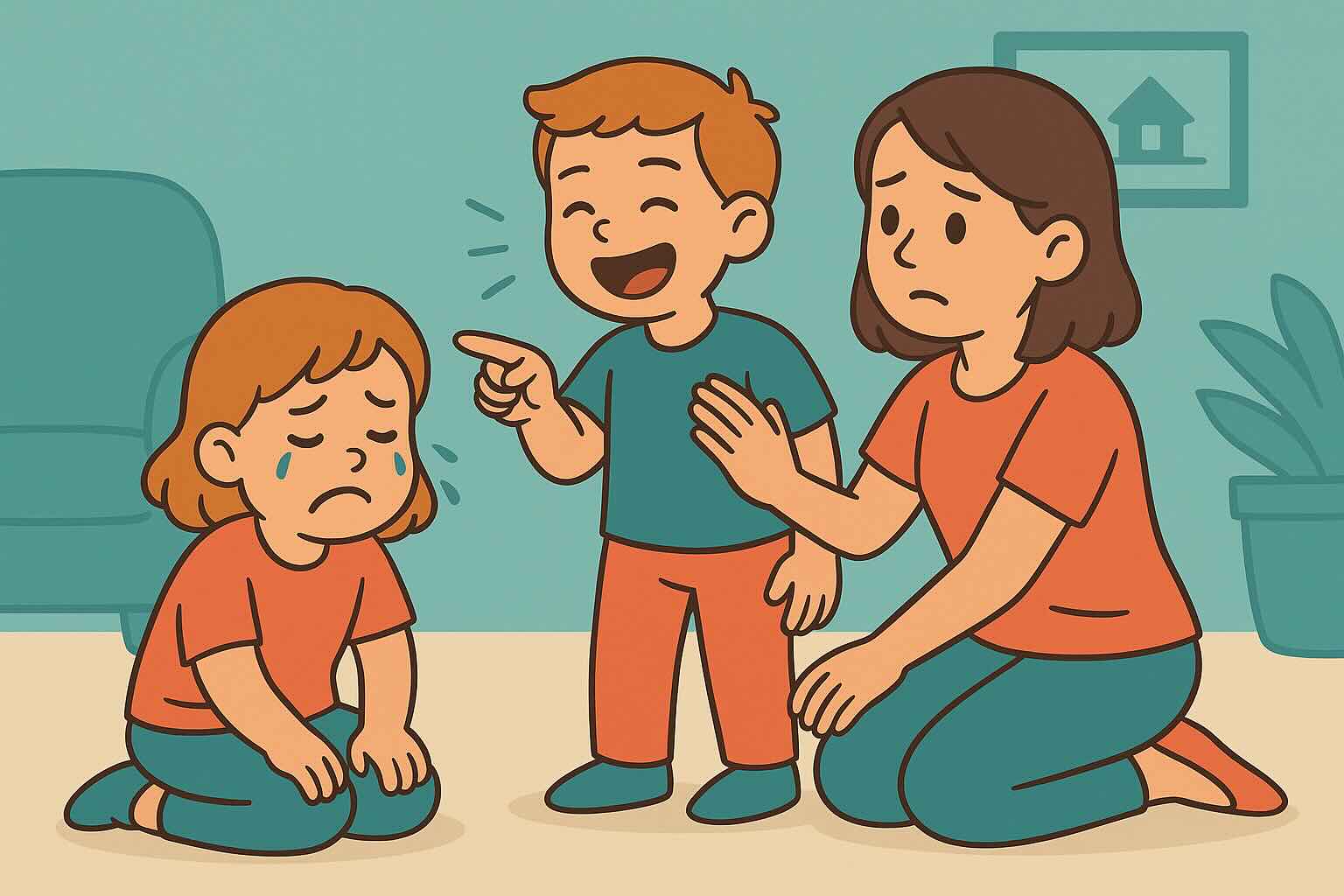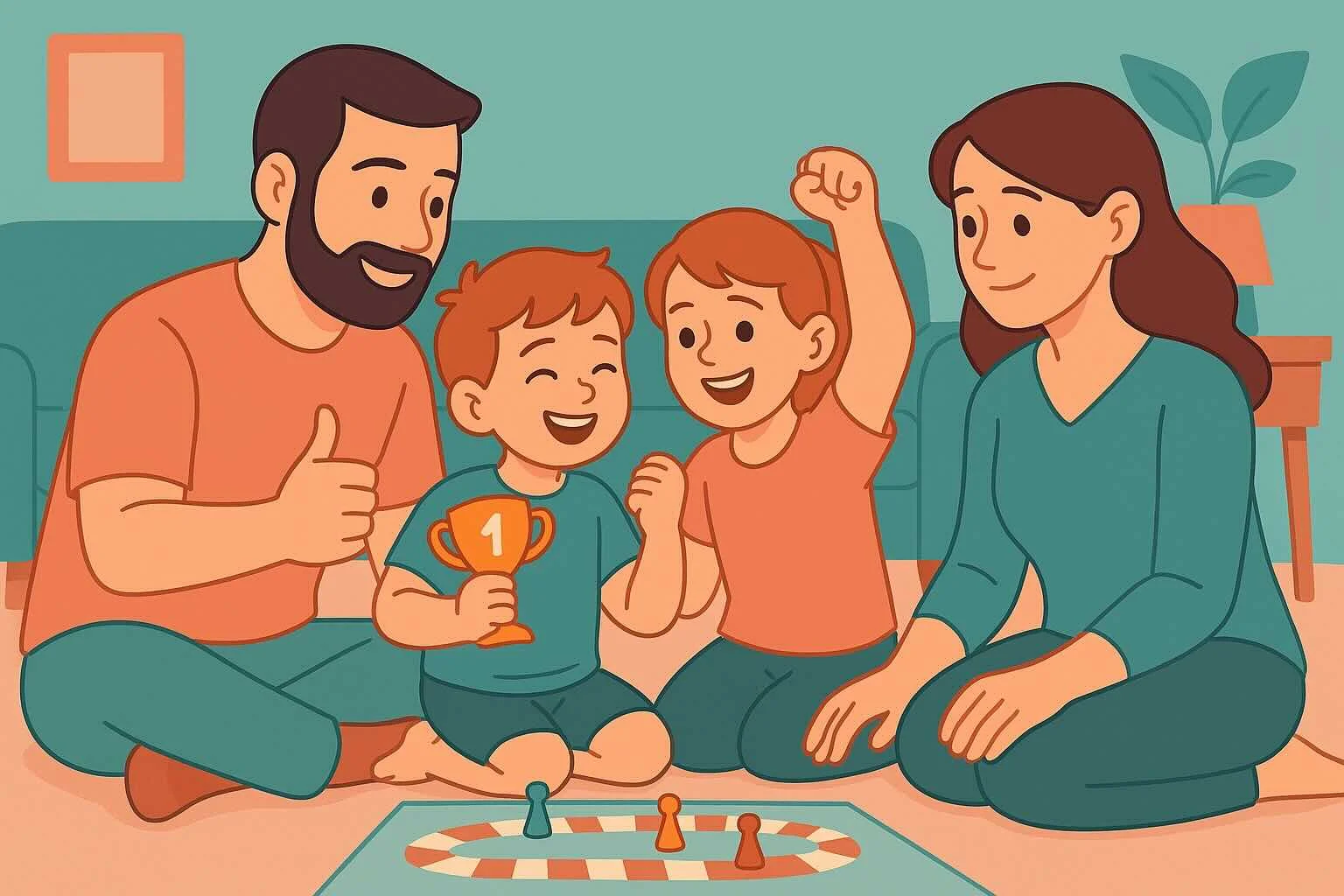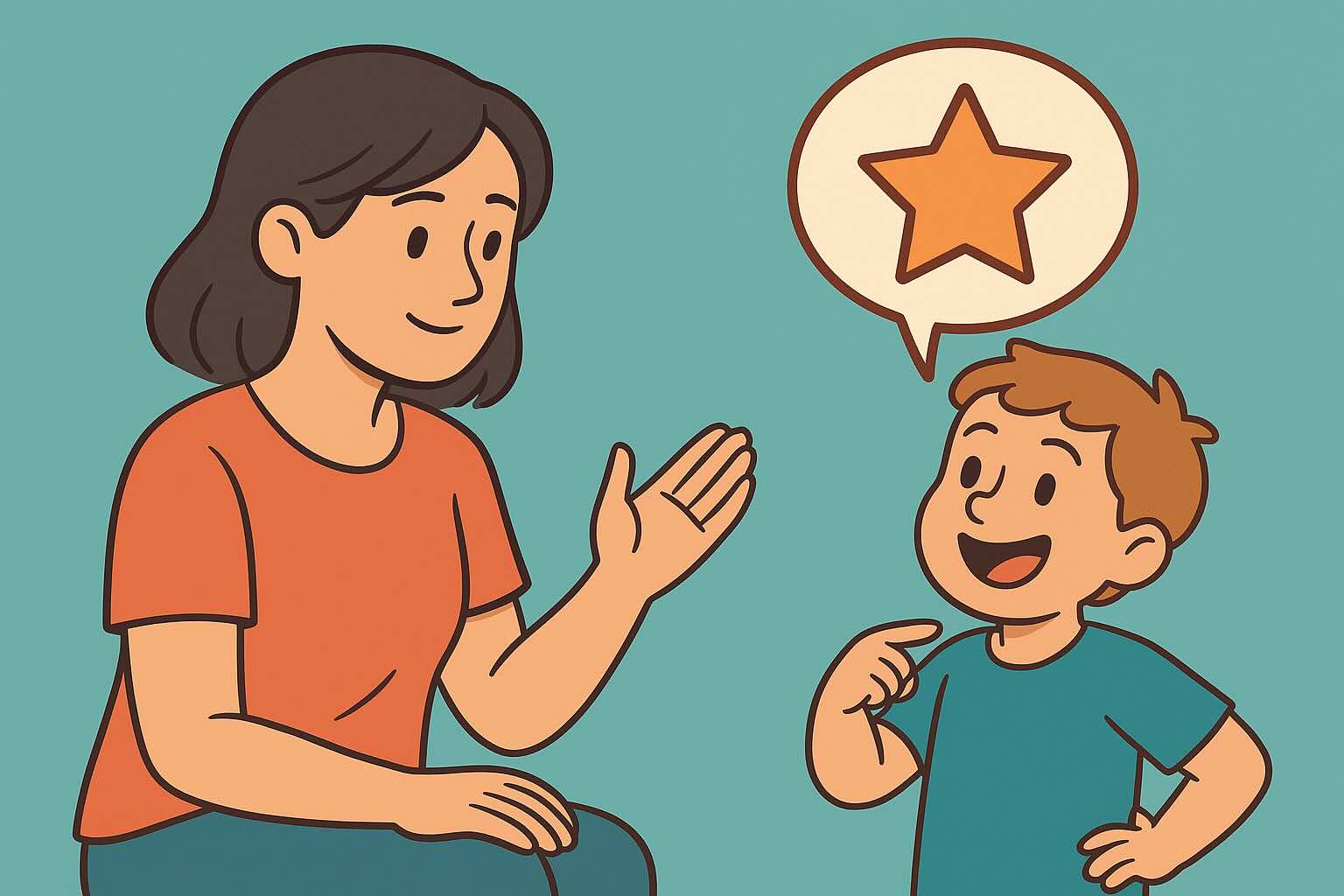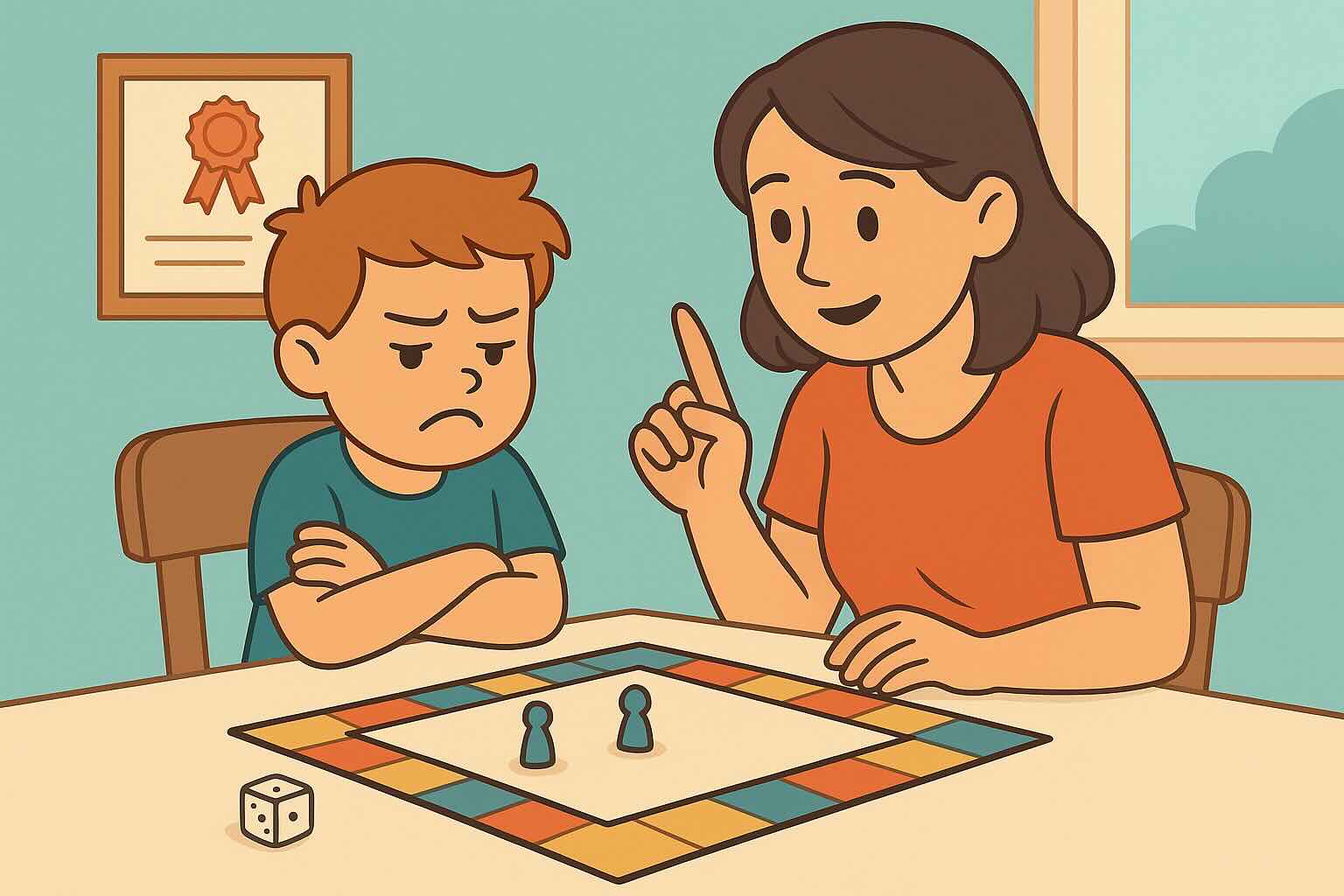Sibling Teasing: 7 Ways to Transform Mean Behavior Into Family Harmony


If your children's interactions have become a constant cycle of teasing, hurt feelings, and your interventions, you're not alone. While some playful teasing between siblings is completely normal, when it becomes one-sided, mean-spirited, or prevents your children from enjoying each other's company, it's time for a different approach.
This comprehensive guide provides evidence-based strategies to help families with children ages 3-7 transform destructive teasing patterns into healthy sibling relationships. Learn to address the underlying emotions driving teasing while teaching both children appropriate conflict resolution and empathy skills.
For related family dynamics, also check out our guides on child bragging behavior and helping competitive children. You may also find our guides on good sportsmanship and social challenges helpful.
What You'll Learn in This Guide
- Normal vs. Problematic Teasing - Understanding when intervention is needed
- The Hidden Emotions - Why children use teasing to meet emotional needs
- The Parent Trap - How well-meaning responses can make teasing worse
- The Both-Child Approach - Addressing teasing without taking sides
- Building Empathy - Teaching perspective-taking and emotional awareness
- Age-Specific Strategies - Tailored approaches for different developmental stages
- Long-Term Family Success - Creating lasting positive sibling relationships
Estimated reading time: 13 minutes
Understanding Sibling Teasing: Normal Development vs. Problem Patterns
What Is Normal Sibling Teasing?
Healthy sibling teasing characteristics:
- Reciprocal: Both children participate and sometimes initiate
- Playful: Contains elements of fun and connection
- Responsive: Stops when one child indicates distress
- Balanced: Doesn't consistently target one child's insecurities
- Situational: Occurs during specific activities, not constantly
Examples of normal teasing:
- Silly nicknames that both children find funny
- Playful competition during games
- Gentle ribbing about harmless mistakes
- Back-and-forth banter that both enjoy
- Teasing that stops when someone says "stop"
When Teasing Becomes Problematic
Warning signs of destructive teasing:
- One-sided: Consistently one child targeting another
- Mean-spirited: Designed to hurt rather than play
- Persistent: Continues despite clear distress signals
- Targeted: Focuses on specific insecurities or sensitivities
- Escalating: Becomes more frequent or intense over time
- Interfering: Prevents siblings from enjoying activities together
Examples of problematic teasing:
- Calling names specifically to upset the other child
- Mocking physical characteristics or abilities
- Teasing about fears or sensitive topics
- Continuing when the other child is clearly upset
- Using teasing to assert dominance or power
The Developmental Context (Ages 3-7)
Why teasing peaks during these years:
Ages 3-4:
- Beginning to understand they can affect others' emotions
- Limited empathy and perspective-taking abilities
- Experimenting with power and control
- May not understand the impact of their words
Ages 5-6:
- Developing social comparison skills
- Testing family hierarchies and relationships
- Increased awareness of sibling differences
- Beginning to understand intentional emotional impact
Ages 7+:
- More sophisticated understanding of emotions
- Capable of complex social strategies
- Better able to understand consequences of behavior
- Ready for advanced empathy and conflict resolution skills
The Hidden Emotions Behind Sibling Teasing
Understanding the Emotional Drivers
Teasing is rarely about the surface topic. Instead, it's usually driven by deeper emotional needs:
1. Jealousy and Sibling Rivalry
- Feeling that the sibling gets more attention, love, or privileges
- Competing for parental approval and recognition
- Resentment about perceived unfairness in treatment
- Fear of being displaced or less loved
2. Power and Control Needs
- Feeling powerless in other areas of life
- Needing to assert dominance or superiority
- Testing their ability to affect others and get reactions
- Seeking control in family dynamics
3. Attention-Seeking Behavior
- Any attention (even negative) feeling better than being ignored
- Learning that teasing guarantees parental intervention
- Competing with sibling for parental focus
- Using conflict to bring family attention to their needs
4. Emotional Regulation Difficulties
- Using teasing to express frustration, anger, or hurt
- Lacking appropriate words or skills to express complex emotions
- Overwhelmed by sibling interactions and reverting to familiar patterns
- Unable to manage intense feelings appropriately
The Parent Trap: How Good Intentions Make Teasing Worse
Common parental responses that accidentally reinforce teasing:
The Protective Approach: "Stop teasing your sister! She's littler than you!"
- Why it backfires: The teaser feels you care more about their sibling
- Result: Increased resentment and more teasing when you're not watching
The Reasoning Approach: "How would you feel if someone teased you like that?"
- Why it backfires: During emotional intensity, children can't access empathy
- Result: Lecture feels like attention, reinforcing the behavior
The Consequence Approach: "If you tease your brother again, you'll lose screen time!"
- Why it backfires: Doesn't address underlying emotions or teach alternatives
- Result: Temporary compliance but underlying issues remain unresolved
The Power Dynamic: Every time a child successfully gets you to react strongly to their teasing, they feel powerful. This sense of power is often more reinforcing than any consequence you provide.
The Both-Child Approach: Addressing Teasing Without Taking Sides
This evidence-based strategy addresses both children's needs simultaneously, preventing the cycle of resentment and escalation.
Step 1: Address Both Children Equally
Instead of focusing only on stopping the teaser or protecting the target:
Traditional approach: "Julia, stop teasing Max! That's not nice!"
Both-child approach: "I can see we have two upset children here. Max, your sister is teasing you and you don't like it. Julia, you seem upset about something too. Let's help both of you."
Step 2: Teach Direct Communication
Help the teased child advocate for themselves: "Max, when someone teases you, you can use your words. Tell Julia 'I don't like it when you call me that name.'"
Even with young children (ages 2-3): "Max, you can say 'No!' when you don't like something. Show Julia - say 'No!'"
Step 3: Redirect the Teaser to Appropriate Expression
Instead of just stopping the behavior: "Julia, teasing isn't the right way to tell Max you're upset with him. Can you use your words? Try saying 'Max, I don't like it when you...'"
Step 4: Address Underlying Emotions
After immediate de-escalation: "Julia, it seems like you were feeling frustrated about something before you started teasing. Can you tell me what was bothering you?"
"Max, when someone teases you, how does that feel in your body? What do you need when you feel that way?"
Building Empathy and Emotional Intelligence
The Perspective-Taking Method
During calm moments, help children understand each other's experiences:
For the child who teases: "When you call Max 'baby,' how do you think that makes him feel? Have you ever felt embarrassed or hurt when someone said something mean to you?"
For the child being teased: "I wonder why Julia might be teasing you. Do you think she might be feeling jealous or left out? That doesn't make teasing okay, but understanding why might help."
The Emotional Vocabulary Building
Teach both children to identify and express emotions appropriately:
Basic emotions (ages 3-5):
- Mad, sad, scared, happy, frustrated, jealous, excited, worried
Advanced emotions (ages 6-7):
- Disappointed, embarrassed, proud, overwhelmed, left out, misunderstood, ignored
Practice phrases:
- "I feel _____ when _____"
- "I need _____ right now"
- "Can you help me with _____?"
- "I don't like it when _____"
The Family Empathy Exercises
Regular family activities to build emotional intelligence:
1. Feeling Check-Ins: Daily or weekly family meetings where everyone shares their emotional experiences
2. Emotion Guessing Games: Practice identifying emotions through facial expressions, body language, and voice tone
3. Story Discussions: Talk about characters' feelings in books and movies, relating them to family experiences
4. Role Reversal Practice: Have children switch roles during calm moments to experience different perspectives
Age-Specific Strategies for Sibling Teasing
Ages 3-4: Building Basic Emotional and Social Skills
Focus areas:
- Simple emotion identification and expression
- Basic empathy development through observation
- Clear, immediate consequences
- Lots of positive interaction modeling
Strategies that work:
- Use very simple language: "Teasing hurts feelings"
- Immediately redirect to appropriate behavior
- Provide lots of physical comfort to both children
- Practice gentle touching and kind words during calm moments
- Create structured positive interaction opportunities
Script examples:
- "Ouch! Teasing hurts. Let's use gentle words."
- "Show me how to be kind to your brother."
- "Both of you seem upset. Let's take some deep breaths together."
Ages 5-6: Developing Complex Emotional Understanding
Focus areas:
- Advanced emotion vocabulary and expression
- Beginning conflict resolution skills
- Understanding cause and effect in relationships
- Building genuine empathy and perspective-taking
Strategies that work:
- Have regular family meetings about feelings and relationships
- Practice problem-solving during calm moments
- Use books and stories to discuss sibling relationships
- Create opportunities for collaborative success
- Establish family rules about respectful communication
Script examples:
- "When you tease your sister, she feels hurt and then doesn't want to play with you. Is that what you want?"
- "Let's think of three ways you could tell your brother you're upset without teasing."
- "How do you think we could solve this problem so both of you feel better?"
Ages 7+: Advanced Conflict Resolution and Family Dynamics
Focus areas:
- Independent conflict resolution skills
- Understanding family dynamics and individual needs
- Taking responsibility for impact on relationships
- Building long-term relationship skills
Strategies that work:
- Teach formal conflict resolution steps
- Discuss the long-term impact of teasing on relationships
- Encourage independent problem-solving with parental support
- Address more complex family dynamics and fairness issues
- Build individual identity separate from sibling comparison
Script examples:
- "What do you think would happen to your relationship with your sister if teasing continues?"
- "How could you handle feeling jealous in a way that brings you closer instead of pushing each other apart?"
- "What would it look like for our family if everyone felt respected and cared for?"
The Reflection Method for Addressing Underlying Issues
Step 1: Individual Conversations About Sibling Dynamics
Have separate, calm conversations with each child:
For the child who teases: "I've been noticing that you've been teasing your brother a lot lately. I'm wondering if you might be feeling jealous or frustrated about something. It's totally okay to have those feelings - everyone does sometimes."
For the child being teased: "I notice that your sister has been teasing you, and that must feel really hard. I also want to help you learn ways to stand up for yourself and handle these situations."
Step 2: Explore Family Dynamics
Help children understand their roles and needs within the family:
"Sometimes when children tease their siblings, it's because they're worried about their place in the family. Do you ever worry that Mom and Dad love your sibling more than you?"
"Everyone in our family is special in their own way. You don't have to prove you're better than your sibling to be loved and valued."
Step 3: Address Specific Triggers
Identify and address situational factors that increase teasing:
- Transitions and schedule changes
- Tiredness and overstimulation
- Feeling excluded from activities
- Academic or social pressures
- Changes in family dynamics
Step 4: Create Prevention Strategies
Work together to identify early warning signs and intervention strategies:
"What happens in your body right before you feel like teasing? Can we create a signal for when you need help with those feelings?"
"When you start feeling left out or jealous, what are some things you can do instead of teasing?"
Building Positive Sibling Relationships
Creating Opportunities for Positive Interaction
Structured cooperation activities:
- Joint projects that require both children's skills
- Team games against parents or external challenges
- Shared responsibilities that benefit the whole family
- Special sibling-only activities and traditions
Individual attention strategies:
- One-on-one time with each child regularly
- Celebrating each child's unique qualities and achievements
- Addressing individual needs and temperaments
- Avoiding comparisons between siblings
Family Rules and Expectations
Establish clear, consistent family guidelines:
Respect Rule: "In our family, we treat each other with respect, even when we're upset."
Problem-Solving Rule: "When we have conflicts, we use our words to solve problems together."
Individual Worth Rule: "Each person in our family is valuable and loved for who they are, not for being better than someone else."
Help and Support Rule: "When someone is struggling, we help them instead of making it harder."
The Family Meeting Approach
Weekly family meetings to address ongoing issues:
Meeting structure:
- Appreciation round: Each person shares something positive about each family member
- Problem-solving time: Address any ongoing conflicts or concerns
- Planning ahead: Discuss upcoming situations that might be challenging
- Fun planning: Schedule positive family activities and sibling bonding time
Sample family meeting topics:
- "How can we help each other when we're feeling frustrated?"
- "What should we do when someone is having a hard day?"
- "How can we make sure everyone feels included in family activities?"
- "What are some ways we can celebrate each other's successes?"
Realistic Expectations: What Change Actually Looks Like
Timeline for Improvement
Week 1-2: Awareness and Initial Resistance
- Begin implementing both-child approach consistently
- Expect possible increase in testing behaviors initially
- Focus on staying calm and consistent with new responses
- Children may resist new expectations and push boundaries
Week 3-4: Beginning Integration
- Start seeing occasional appropriate conflict resolution
- Teasing may decrease in frequency but still occur during stress
- Children begin using some new vocabulary and strategies
- Family dynamics start shifting as roles become less rigid
Week 5-8: Noticeable Progress
- More frequent appropriate expression of emotions
- Siblings beginning to problem-solve together occasionally
- Reduced intensity and duration of teasing episodes
- Improved overall family atmosphere during daily activities
Months 3-6: Established New Patterns
- Generally respectful sibling interactions most of the time
- Independent conflict resolution skills developing
- Positive sibling activities increase naturally
- Family relationships feel more harmonious and connected
What Success Really Looks Like
Success does NOT mean:
- Siblings never have conflicts or disagreements
- Complete elimination of all teasing or playful banter
- Perfect harmony at all times
- Children never need adult guidance for conflicts
Success DOES mean:
- Conflicts resolve more quickly and respectfully
- Teasing that does occur is lighter and stops when requested
- Siblings show genuine care and concern for each other
- Family activities are generally enjoyable for everyone
- Children can advocate for themselves appropriately
- Both children feel valued and loved within the family
When to Seek Professional Help
Warning Signs That Warrant Professional Support
- Sibling teasing escalates to physical aggression regularly
- One child shows persistent anxiety or fear around their sibling
- Teasing patterns don't improve after 8-10 weeks of consistent intervention
- Child being teased develops concerning behaviors (withdrawal, aggression elsewhere)
- Family functioning significantly impacted for more than 3 months
- Teasing includes threats, destruction of property, or extreme cruelty
- Underlying mental health concerns (anxiety, depression) in either child
- Sibling relationship seems to be causing lasting emotional harm
Types of Professional Support
Family therapists specialize in sibling dynamics and can help address complex family patterns
Child psychologists can help with individual emotional regulation and underlying mental health needs
Parenting coaches provide specific strategies for managing sibling conflicts and family dynamics
School counselors can support children who bring sibling issues into peer relationships
Real-Life Success Stories
The Johnson Family: From Daily Battles to Genuine Friendship
"Emma (6) and Sam (4) were constantly at each other's throats. Emma would tease Sam about everything - his toys, his friends, how he talked. Sam would have meltdowns, and I'd end up yelling at Emma to leave him alone. I realized I was making Emma feel like I always took Sam's side. We started addressing both kids whenever teasing happened - helping Sam use his words and helping Emma express her frustrations appropriately. We also started having special one-on-one time with Emma and regular family meetings. It took about 2 months, but now they actually play together voluntarily and Emma often helps Sam when he's struggling. They still have conflicts, but they usually work them out themselves now."
The Martinez Family: Overcoming Age Gap Challenges
"With a 7-year-old and 3-year-old, the teasing was so one-sided. Carlos would constantly mock little Sofia's pronunciation and baby toys. We started helping Carlos understand that Sofia looked up to him and wanted to be like him, not compete with him. We also gave him special 'big brother' responsibilities like helping her learn new things. We practiced how to be proud of his own abilities without putting her down. Sofia learned to say 'Stop, I don't like that' clearly. Now Carlos actually enjoys teaching Sofia things and protecting her. He went from being her biggest critic to her biggest supporter."
The Chen Family: Addressing Underlying Jealousy
"Lily felt like her younger brother got all the attention because of his special needs. Her teasing was really mean-spirited and seemed designed to get him in trouble or upset. We realized she was feeling invisible and unloved. We started individual therapy for Lily to address her feelings, and family therapy to work on our dynamics. We also created special traditions just for Lily and made sure she got individual attention regularly. It took about 4 months, but the teasing stopped completely once she felt secure in her place in the family. Now she's one of her brother's best advocates."
Your 8-Week Action Plan for Reducing Sibling Teasing
Weeks 1-2: Assessment and Foundation Building
- Track when, where, and why teasing occurs most frequently
- Begin using both-child approach instead of taking sides
- Start individual conversations with each child about sibling dynamics
- Focus on staying calm and consistent with new responses
Weeks 3-4: Skill Building and Empathy Development
- Teach both children appropriate ways to express frustration and needs
- Practice perspective-taking exercises during calm family time
- Establish clear family rules about respectful communication
- Begin weekly family meetings to address issues proactively
Weeks 5-6: Integration and Problem-Solving
- Encourage children to use new skills independently
- Address underlying emotional needs (jealousy, attention, control)
- Create more opportunities for positive sibling interaction
- Celebrate progress and appropriate conflict resolution
Weeks 7-8: Independence and Long-Term Relationship Building
- Support children in resolving conflicts with minimal adult intervention
- Focus on building genuine sibling connection and friendship
- Address any remaining patterns or triggers
- Plan for long-term maintenance of positive family dynamics
Building Long-Term Sibling Relationships
Teaching Conflict Resolution Life Skills
Every sibling conflict is an opportunity to teach valuable life skills:
Communication skills:
- Expressing needs and feelings clearly
- Active listening and empathy
- Negotiation and compromise
- Respectful disagreement
Emotional regulation:
- Managing frustration and disappointment
- Taking breaks when emotions are high
- Self-advocacy and boundary setting
- Supporting others during difficult times
Relationship skills:
- Forgiveness and repair after conflicts
- Celebrating others' successes genuinely
- Collaborative problem-solving
- Building trust and mutual respect
The Long-Term Vision
Help your children understand that their sibling relationship is likely to be one of the longest relationships of their lives:
"Your sister will probably be in your life longer than almost anyone else. The way you treat each other now is building the foundation for your relationship as teenagers, adults, and maybe even when you're old grandparents together."
"Learning to work out problems with your brother now is practice for all the relationships you'll have in your life - with friends, classmates, teammates, and someday maybe your own family."
Key Takeaways: Transforming Sibling Teasing into Family Harmony
- ✅ Address both children equally instead of taking sides during conflicts
- ✅ Understand that teasing often masks deeper emotions like jealousy, powerlessness, or need for attention
- ✅ Teach direct communication skills to both the teaser and the target
- ✅ Use calm moments for reflection and skill-building conversations
- ✅ Create opportunities for positive sibling interaction and individual attention
- ✅ Build empathy through perspective-taking and emotional vocabulary development
- ✅ Expect gradual improvement over 6-8 weeks with consistent approach
- ✅ Focus on long-term relationship building rather than just stopping negative behavior
- ✅ Model respectful conflict resolution in your own relationships and interactions
Remember: Sibling teasing is often a sign that children need help expressing complex emotions and navigating family relationships. With patience, consistency, and focus on underlying needs, most sibling relationships can transform from antagonistic to genuinely supportive and loving.
This article is based on family systems theory, developmental psychology research, and sibling relationship intervention studies. Individual results vary based on family dynamics, child temperament, and consistency of implementation. Seek professional support if sibling conflicts significantly impact family functioning or individual child wellbeing.
Multi-Child Support
Manage profiles for multiple children with personalized conversations and age-appropriate advice for each child.

Sibling Harmony Toolkit
Stop sibling teasing and build family harmony with both-child approaches, empathy exercises, and conflict resolution strategies.
Frequently Asked Questions
Need personalized support?
RootWise's AI coach can provide tailored strategies for your specific situation, available 24/7 when you need it most.
Learn More About AI Coaching →



